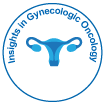Immunotherapy in Cervical Cancer: Mechanisms, Clinical Outcomes, and Future Directions
Received: 01-Feb-2025 / Manuscript No. ctgo-25-168497 / Editor assigned: 03-Feb-2025 / PreQC No. ctgo-25-168497(PQ) / Reviewed: 17-Feb-2025 / QC No. ctgo-25-168497 / Revised: 21-Feb-2025 / Manuscript No. ctgo-25-168497(R) / Published Date: 28-Feb-2025
Abstract
Cervical cancer, primarily driven by human papillomavirus (HPV), remains a global health challenge, particularly in low-resource settings. Immunotherapy, including anti-PD-1/PD-L1 inhibitors and HPV-targeted therapeutic vaccines, has emerged as a promising treatment for advanced or recurrent disease. This article reviews the mechanisms, clinical trial outcomes, and challenges of immunotherapy in cervical cancer. Key trials like CheckMate 358 demonstrate significant response rates with nivolumab, while vaccine-based approaches show potential in early-stage disease. Challenges include limited efficacy in non-HPV-driven tumors and managing immune-related toxicities. Future directions involve combination therapies and biomarker development to enhance outcomes.
Keywords
Cervical cancer; immunotherapy; HPV; PD-1 inhibitors; therapeutic vaccines; clinical trials; immune checkpoint inhibitors; combination therapy; biomarkers; gynecologic oncology
Introduction
Cervical cancer is the fourth most common cancer in women globally, with over 600,000 new cases and 340,000 deaths annually [1]. Persistent HPV infection drives most cases, making immunotherapy an attractive strategy due to the virus’s immunogenic nature [2]. Immune checkpoint inhibitors, such as nivolumab and pembrolizumab, target PD-1/PD-L1 pathways to restore antitumor immunity, while therapeutic vaccines aim to enhance HPV-specific T-cell responses [3]. Despite advances, only a subset of patients responds, particularly those with recurrent or metastatic disease [4]. This article synthesizes evidence from clinical trials, discusses resistance mechanisms, and explores the role of immunotherapy in transforming cervical cancer care.
Discussion
Immune checkpoint inhibitors have shown promise in advanced cervical cancer. The CheckMate 358 trial evaluated nivolumab in recurrent or metastatic HPV-positive cervical cancer, reporting a 26% objective response rate (ORR) and median progression-free survival (PFS) of 5.1 months [5]. Pembrolizumab, approved by the FDA for PD-L1-positive recurrent cervical cancer, demonstrated a 14.6% ORR in the KEYNOTE-158 trial, with durable responses in responders [6]. However, efficacy is lower in PD-L1-negative tumors, highlighting the need for predictive biomarkers [7]. Therapeutic vaccines targeting HPV E6 and E7 oncoproteins are under investigation, particularly for early-stage or pre-invasive disease. The VGX-3100 vaccine, a DNA-based therapy, induced regression of high-grade cervical intraepithelial neoplasia (CIN) in 49.5% of patients in a phase IIb trial [8]. Combining vaccines with checkpoint inhibitors is a promising strategy, with early trials showing enhanced T-cell responses [9]. Challenges include immune-related adverse events (irAEs), such as colitis and hepatitis, occurring in 20–30% of patients on PD-1 inhibitors [10]. Resistance mechanisms, including tumor microenvironment immunosuppression, limit efficacy in non-HPV-driven or PD-L1-low tumors. Combination therapies, such as pembrolizumab with chemotherapy (KEYNOTE-826), have improved PFS by 3.5 months compared to chemotherapy alone. Biomarker development, including HPV-specific immune signatures and PD-L1 expression, is critical to optimize patient selection.
Results
In CheckMate 358, nivolumab achieved a 26% ORR in recurrent cervical cancer, with a median duration of response of 23.3 months [5]. KEYNOTE-158 reported a 14.6% ORR for pembrolizumab in PD-L1-positive tumors, with 12% of patients achieving complete responses [6]. The KEYNOTE-826 trial showed a median PFS of 10.4 months with pembrolizumab plus chemotherapy versus 6.9 months with chemotherapy alone (HR 0.62). VGX-3100 induced CIN regression in 49.5% of patients, with sustained responses at 18 months [8]. irAEs occurred in 25% of patients on checkpoint inhibitors, with 5–10% experiencing grade 3 events [10]. Biomarker-positive patients (e.g., high PD-L1 expression) had response rates up to 30% higher than biomarker-negative cohorts [7].
Conclusion
Immunotherapy, particularly PD-1 inhibitors and HPV-targeted vaccines, offers significant potential for cervical cancer treatment, especially in recurrent or metastatic settings. While response rates and durability are encouraging, challenges like resistance and toxicities necessitate innovative approaches. Combination therapies and biomarkers will be pivotal in expanding immunotherapy’s reach. Ongoing trials and global access initiatives are essential to ensure equitable benefits, particularly in high-burden regions.
Citation: Laura MO (2025) Immunotherapy in Cervical Cancer: Mechanisms,Clinical Outcomes, and Future Directions. Current Trends Gynecol Oncol, 10: 257.
Copyright: © 2025 Laura MO. This is an open-access article distributed under theterms of the Creative Commons Attribution License, which permits unrestricteduse, distribution, and reproduction in any medium, provided the original author andsource are credited.
Select your language of interest to view the total content in your interested language
Share This Article
Recommended Journals
Open Access Journals
Article Usage
- Total views: 198
- [From(publication date): 0-0 - Oct 20, 2025]
- Breakdown by view type
- HTML page views: 151
- PDF downloads: 47
